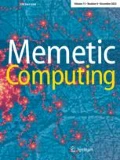Abstract
The generalized Weighted Relevance Aggregation Operator (WRAO) is a non-additive aggregation function. The Ordered Weighted Aggregation Operator (OWA) (or its generalized form: Generalized Ordered Weighted Aggregation Operator (GOWA)) is more restricted with the additivity constraint in its weights. In addition, it has an extra weights reordering step making it hard to learn automatically from data. Our intension here is to compare the efficiency (or effectiveness) of learning these two types of aggregation functions from empirical data. We employed two methods to learn WRAO and GOWA: Levenberg–Marquardt (LM) and a Genetic Algorithm (GA) based method. We use UCI (University of California Irvine) benchmark data to compare the aggregation performance of non-additive WRAO and additive GOWA. We found that the non-constrained aggregation function WRAO was learnt well automatically and produced consistent results, while GOWA was learnt less well and quite inconsistently.
Similar content being viewed by others
References
Asuncion A, Newman D (2007) UCI machine learning repository. http://www.ics.uci.edu/~mlearn/MLRepository.html
Beliakov G (2005) Learning weights in the generalized owa operators. Fuzzy Optim Decision Making 4(2): 119–130
Beliakov G, Warren J (2001) Appropriate choice of aggregation operators in fuzzy decisionsupport systems. Fuzzy Syst IEEE Trans 9(6): 773–784
Ben-Arieh D (2005) Sensitivity of multi-criteria decision making to linguistic quantifiers and aggregation means. Comput Indus Eng 48(2): 289–309
Bordogna G, Pasi G (2005) Personalised indexing and retrieval of heterogeneous structured documents. Inform Retriev 8(2): 301–318
Botzheim J, Kóczy LT, Ruano AE (2002) Extension of the levenberg–marquardt algorithm for the extractionof trapezoidal and general piecewise linear fuzzy rules. In: Fuzzy systems, 2002. FUZZ-IEEE’02. Proceedings of the 2002 IEEE international conference on, vol. 1
Dennis J Jr, Gay D, Walsh R (1981) An adaptive nonlinear least-squares algorithm. ACM Trans Math Softw 7(3): 348–368
Dubois D, Prade H (1986) Weighted minimum and maximum operations in fuzzy set theory. Info Sci 39(2): 205–210
Dyckhoff H, Pedrycz W (1984) Generalized means as model of compensative connectives. Fuzzy Sets Syst 14(2): 143–154
Filev D, Yager R (1998) On the issue of obtaining owa operator weights. Fuzzy Sets Syst 94(2): 157–169
Fletcher R (1987) Practical methods of optimization. Wiley, New York
Fodor J, Marichal J, Roubens M (1994) Characterization of some aggregation functions arising from mcdm problems. Proc IPMU 94: 1026–1031
Fodor J, Marichal J, Roubens M (1995) Characterization of the ordered weighted averaging operators. Fuzzy Syst IEEE Trans 3(2): 236–240
Gill P, Murray W, Wright M (1981) Practical optimization. Academic Press, London
Goldberg D (1989) Genetic algorithms in search, optimization and machine learning. Addison-Wesley Longman Publishing Co., Reading
Haupt R, Haupt S (2004) Practical genetic algorithms. Wiley, London
Herrera F, López E, Mendaña C, Rodríguez M (2001) A linguistic decision model for personnel management solved with a linguistic biobjective genetic algorithm. Fuzzy Sets Syst 118(1): 47–64
Holland J (1975) Adaptation in natural and artificial systems. University of Michigan Press, Ann Arbor
Kacprzyk J, Wilbik A, Zadrozny S (2007) Linguistic summaries of time series via an OWA operator based aggregation of partial trends. In: IEEE international fuzzy systems conference. FUZZ-IEEE 2007, pp 1–6
Koza J (1992) Genetic programming: on the programming of computers by means of natural selection. MIT Press, Cambridge
Levenberg K (1944) A method for the solution of certain nonlinear problems in least squares. Q Appl Math 2: 164–168
Manna S, Mendis BSU, Gedeon TD (AUG 2009) Hierarchical document signature: a specialized application of fuzzy signature for document computing. FUZZ-IEEE 2009 international conference on Fuzzy systems, pp 1–6
Marquardt D (1963) An algorithm for least-squares estimation of nonlinear parameters. J Soc Indus Appl Math 11(2): 431–441
Mendis BSU (2008) Fuzzy signatures: Hierarchical fuzzy systems and alpplications. Ph.D. thesis, College of Engineering and Computer Science, The Australian National University, Australia
Mendis BSU, Gedeon TD (2008) Aggregation selection for hierarchical fuzzy signatures: a comparison of hierarchical owa and wrao. In: International conference of information processing and management of uncertainty in knowledge based systems (IPMU), pp 1–8
Mendis BSU, Gedeon TD (2008) A comparison: Fuzzy signatures and choquet integral. In: IEEE world congress on computational intelligence, WCCI, Hong Kong, pp 1464–1471
Mendis BSU, Gedeon TD, Botzheim J, Kóczy LT (2006) Generalised weighted relevance aggregation operators for hierarchical fuzzy signatures. In: International conference on computational inteligence for modelling control and automation and international conference on intelligent agents web technologies and international commerce (CIMCA’06). Sydney, Australia, pp 198–203
Mendis BSU, Gedeon TD, Kóczy LT (2006) Learning generalized weighted relevance aggregation operators using levenberg–marquardt method. In: Sixth international conference on hybrid intelligent systems (HIS’06) and 4th conference on neuro-computing and evolving intelligence (NCEI 06’). New Zealand, pp 1–6
Meuth R, Lim M, Ong Y, Wunsch D (2009) A proposition on memes and meta-memes in computing for higher-order learning. Memetic Comput 1(2): 85–100
Miller J, Potter W, Gandham R, Lapena C (1993) An evaluation of local improvement operators for genetic algorithms. IEEE Trans Syst Man Cybernet SMC 23: 1340–1340
Mor J (1977) The levenberg–marquardt algorithm: implementation and theory. Lecture Notes Math 630: 105–116
Srinivas M, Patnaik L (1994) Genetic algorithms: a survey. Computer 27(6): 17–26
Torra V, Godo L (2002) Continuous WOWA operators with application to defuzzification. Aggregation operators: new trends and applications, p 159
Wong K, Gedeon T, Kóczy L (2004) Construction of fuzzy signature from data: an example of sars pre-clinical diagnosis system. Fuzzy systems, 2004. In: Proceedings of 2004 IEEE international conference on, vol 3
Yager R (1988) On ordered weighted averaging aggregation operators in multicriteria decisionmaking. IEEE Trans Syst Man Cybernet 18(1): 183–190
Yager R (2004) Generalized owa aggregation operators. Fuzzy Optim Decision Making 3(1): 93–107
Zhu D, Mendis BSU, Gedeon TD, Asthana A, Goecke R (2008) A hybrid fuzzy approach for human eye gaze pattern recognition. In: 15th international conference on neural information processing (ICONIP08), vols. 1–8. Auckland, New Zealand
Author information
Authors and Affiliations
Corresponding author
Rights and permissions
About this article
Cite this article
Mendis, B.S.U., Gedeon, T.D. WRAO and OWA learning using Levenberg–Marquardt and genetic algorithms. Memetic Comp. 3, 101–110 (2011). https://doi.org/10.1007/s12293-010-0054-3
Received:
Accepted:
Published:
Issue Date:
DOI: https://doi.org/10.1007/s12293-010-0054-3




